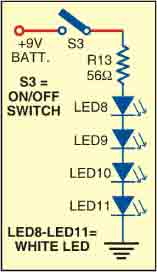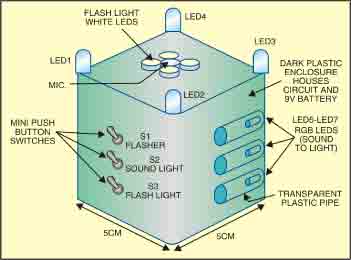 This multi-utility flashlight consists of three sections: a flasher, a sound-to-light display and a white LED-based flashlight.
This multi-utility flashlight consists of three sections: a flasher, a sound-to-light display and a white LED-based flashlight.
Multi-utility flashlight circuit

The flasher circuit is built around an NE555 timer IC that is wired as an astable multivibrator. It flashes a pair of LEDs alternatively. The frequency of the astable multivibrator can be varied using preset VR1.


The working of the sound-to-light display circuit shown above is simple. The condenser microphone (MIC) picks up the sound in its vicinity and outputs a low voltage. The low output of the microphone is boosted by the first section (A1) of dual op-amp LM358. The output of op-amp A1 is fed to the second section (A2) of LM358 to drive transistor T1 (2N2222). The three RGB LEDs flash accordingly. (An RGB LED is actually a two-pin white LED package that glows red, green and blue sequentially when powered.)
The flashlight circuit consists of a group of four white LEDs connected in series. Resistor R13 limits the current flowing through the white LEDs (LED8 through LED11).
Construction & testing

Assemble the entire circuit including the flasher, sound-to-light display and flashlight on a general-purpose PCB and enclose in a cabinet. Connect the flasher LEDs (LED1 through LED4) on top of the box and the condenser microphone and flashlight white LEDs (LED8-LED11) in the middle of the top as shown here. Connect the three switches to select any one function or the combination of two or three sections.
The article was first published in April 2010 and has recently been updated.






It doesn’t work
Kindly elaborate your query.